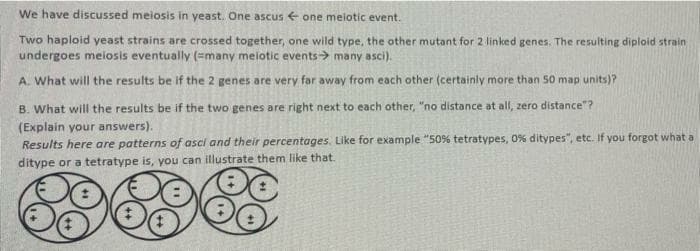Two haploid yeast strains are crossed together, one wild type, the other mutant for 2 linked genes. The resulting diploid strain undergoes meiosis eventually (=many meiotic events> many asci). A. What will the results be if the 2 genes are very far away from each other (certainly more than 50 map units)? B. What will the results be if the two genes are right next to each other, "no distance at all, zero distance"? (Explain your answers). Results here are patterns of asci and their percentages. Like for example "50% tetratypes, 0% ditypes", etc. If you forgot what a ditype or a tetratype is, you can illustrate them like that.
Two haploid yeast strains are crossed together, one wild type, the other mutant for 2 linked genes. The resulting diploid strain undergoes meiosis eventually (=many meiotic events> many asci). A. What will the results be if the 2 genes are very far away from each other (certainly more than 50 map units)? B. What will the results be if the two genes are right next to each other, "no distance at all, zero distance"? (Explain your answers). Results here are patterns of asci and their percentages. Like for example "50% tetratypes, 0% ditypes", etc. If you forgot what a ditype or a tetratype is, you can illustrate them like that.
Human Anatomy & Physiology (11th Edition)
11th Edition
ISBN:9780134580999
Author:Elaine N. Marieb, Katja N. Hoehn
Publisher:Elaine N. Marieb, Katja N. Hoehn
Chapter1: The Human Body: An Orientation
Section: Chapter Questions
Problem 1RQ: The correct sequence of levels forming the structural hierarchy is A. (a) organ, organ system,...
Related questions
Topic Video
Question

Transcribed Image Text:We have discussed meiosis in yeast. One ascus e one melotic event.
Two haploid yeast strains are crossed together, one wild type, the other mutant for 2 linked genes. The resulting diploid strain
undergoes melosis eventually (=many meiotic events > many asci).
A. What will the results be if the 2 genes are very far away from each other (certainly more than 50 map units)?
B. What will the results be if the two genes are right next to each other, "no distance at all, zero distance"?
(Explain your answers).
Results here are patterns of asci and their percentages. Like for example "50% tetratypes, 0% ditypes", etc. If you forgot what a
ditype or a tetratype is, you can illustrate them like that.
Expert Solution
This question has been solved!
Explore an expertly crafted, step-by-step solution for a thorough understanding of key concepts.
This is a popular solution!
Trending now
This is a popular solution!
Step by step
Solved in 2 steps

Knowledge Booster
Learn more about
Need a deep-dive on the concept behind this application? Look no further. Learn more about this topic, biology and related others by exploring similar questions and additional content below.Recommended textbooks for you

Human Anatomy & Physiology (11th Edition)
Biology
ISBN:
9780134580999
Author:
Elaine N. Marieb, Katja N. Hoehn
Publisher:
PEARSON

Biology 2e
Biology
ISBN:
9781947172517
Author:
Matthew Douglas, Jung Choi, Mary Ann Clark
Publisher:
OpenStax

Anatomy & Physiology
Biology
ISBN:
9781259398629
Author:
McKinley, Michael P., O'loughlin, Valerie Dean, Bidle, Theresa Stouter
Publisher:
Mcgraw Hill Education,

Human Anatomy & Physiology (11th Edition)
Biology
ISBN:
9780134580999
Author:
Elaine N. Marieb, Katja N. Hoehn
Publisher:
PEARSON

Biology 2e
Biology
ISBN:
9781947172517
Author:
Matthew Douglas, Jung Choi, Mary Ann Clark
Publisher:
OpenStax

Anatomy & Physiology
Biology
ISBN:
9781259398629
Author:
McKinley, Michael P., O'loughlin, Valerie Dean, Bidle, Theresa Stouter
Publisher:
Mcgraw Hill Education,

Molecular Biology of the Cell (Sixth Edition)
Biology
ISBN:
9780815344322
Author:
Bruce Alberts, Alexander D. Johnson, Julian Lewis, David Morgan, Martin Raff, Keith Roberts, Peter Walter
Publisher:
W. W. Norton & Company

Laboratory Manual For Human Anatomy & Physiology
Biology
ISBN:
9781260159363
Author:
Martin, Terry R., Prentice-craver, Cynthia
Publisher:
McGraw-Hill Publishing Co.

Inquiry Into Life (16th Edition)
Biology
ISBN:
9781260231700
Author:
Sylvia S. Mader, Michael Windelspecht
Publisher:
McGraw Hill Education